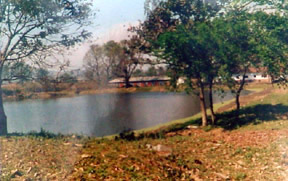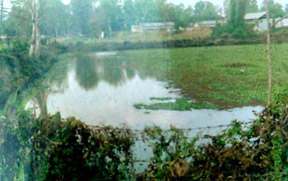|
Received 25 April 2002
Meiti, INDIA
A submission by
CORE Manipur Loisanglen, India
Contact: D. Roy Laifungbam
Ghari, Airport Road, Imphal 795001, Manipur, India
Tel: +91 361 228709; +91 385 441339; Fax: +91 361 228730; Email:
core@del3.vsnl.net.in
KANGLA PUNGMAYOL:
LAIPHAM OF THE MEITEI - INDIGENOUS PEOPLE OF MANIPUR
Cultural Heritage
and Sacred Sites: World Heritage from an Indigenous Perspective Manhattan,
New York City, 15 May 2002
1. We commend the Panel Discussion on the
Cultural Heritage and Sacred Sites: World Heritage from an Indigenous
Perspective. We also believe that this panel, held in the International
Year of Cultural Heritage, is very timely and appropriate as it is held in
conjunction with the inaugural session of the Permanent Forum on
Indigenous Issues.
The Kangla Pungmayol: Historic Laipham, Property and Soul of Meitei (Manipur)
2. The Meitei of the indigenous nation,
Manipur in India's North Eastern region believe that their dragon-serpent
ancestor - Pakhangba - was instrumental in beginning a new era of Meitei
civilization based on a collective identity concept. There are known to be
nine Meitei tribes that came together to form the consolidated Meitei
people of today - Ningthouja, Luwang, Angom, Khuman, Moirang, Chenglei,
Khaba-Nganba, Mangang and Heirem Khunjan Uchiwa. The Ningthouja believe
that they are the descendants of Pakhangba. The Kangla (or Kangla
Pungmayol) was the "capital" settlement of the Ningthouja and the
Khaba-Nganba. Pakhangba was said to emerge from a cave (Surung or hole)
situated in the Kangla Pungmayol.
4. The Meitei believe that the Kangla is the centre of the Earth, which is
floating in the Space or Universe. It is the sacred place where
Aatee-ngang Guru's first son, Pakhangba, who reigned as a God King for the
first time in the prehistoric period. The palace must have 9 rooms; and if
re-built, its feature must be similar to the former structure of which was
there before the British invaded Manipur and destroyed it in 1891.
5. According to early maps (on leaf manuscripts) of the Kangla, which is
situated in the centre of Imphal Valley (elevation: approximately 1500
meters above MSL in the Eastern Himalayas) at the present Imphal City
(capital of Manipur state), all the laiphams (sacred landmarks) are
identified according to the paaphal (ritualized coils) of the
dragon-serpent ancestor Pakhangba. Every part of this approximately
one-square mile area has mythological and religious significance for
the Meitei. The Ningthous (hereditary chiefs) of the Meitei resided with
their families in the Kangla, in a special citadel enclosure. The Kangla
was an elaborate fortified sacred enclosure for many centuries. It is
surrounded by a moat called the Thanga-Pat. Meitei ritual worship
continues till this day, but in a restricted and limited way.
3. In the history of the past over a century, since the British occupied
it after defeating Manipur in 1891, the Kangla has not been accessible to
the Meitei. The fort and sacred structures were bombarded by cannon and
destroyed, the chief and his family were turned out and the British Army
occupied it continuously till 1947 as a military cantonment. They built
barracks, workshops and offices upon all the sacred sites and kept the
ruins un-attended as a reminder to the people of Manipur of the defeat of
1891.
4. In 1947, when the British finally left Manipur, the Indian army moved
in and continued to occupy it as a military cantonment after a
controversial Merger Agreement that brought Manipur into a political union
with India, even though the Kangla was supposed to have been retroceded to
the Meitei by the British authorities when they left on 14 August 1947. In
spite of heavy military gates and barricades, Meitei religious "priests"
called Maiba (male) and Maibi (female) continue to forcibly enter and
conduct some limited worship at these sites within the Kangla during the
annual cycle of worship according to the ancient Sanamahi religion of
Manipur. But un-hindered and full observations of the rituals were never
carried out and the people always had to seek the permission of the
cantonment commandant to gain entry.
5. This restriction and insulting practice serves as a symbolic oppression
that signifies the defeat and subjugation of the Meitei till this day. It
is a violation of the fundamental rights according to India's Constitution
and a violation of the International Bill of Rights to which India is a
State Party. Enigmatically, while India regained "freedom" in 1947,
Manipur passed from one form of defeat into another. The Meitei have very
little knowledge today of the true extent of the desecration and
destruction of the Kangla's laiphams (sacred sites) at the hands of the
resident Indian security forces because it is continuously hidden from
public view.
Important Laiphams and religious functions of Kangla
6. The list given below is by no means
exhaustive or complete but it is meant to serve as an illustrative one to
demonstrate the profound significance of the Kangla to the Meitei and
Manipur.
a. Abode and portal (Surung) Pakhangba: Ancestor of the Meitei Ningthouja
b. Utra Sanglen or ( Kuchu Sanglen) is the building of the Traditional
Royal Court, and Utra Phambal is the place where the Ningthou used to
ascend the throne and rule for justice
c. Meil Surung, the Khoidou of the Earth (the centre of the Earth). The
Utra Phambal is placed on it.
d. Tarei: Cremation place of the Chiefs
e. Lu-phou-nung: Place of last rites for the Meitei chiefs
f. Kuchu: Place for oaths-taking among the clans - Treaty making site
g. Cheiraap: Traditional courts including the women's court, Pacha
h. Cheithaaba: Annual spring ritual to formally announce a new year
i. Temple of Yumjaolairema: temple of the ancestress Yumjaoleirembi
j. Nungjeng: a small water tank which has religious significance that
belongs to Pakhangba
k. Kwaak-taanba: Annual ritual to bring security and peace to the nation
l. Numerous ritual and prayers to our ancestors for the peace, prosperity
and security of Manipur and its people (The Kangla is full of laiphams)
The Frustrating Case of the Kangla:
Indigenous Rights Violation
7. The people of Manipur have been
petitioning, requesting and crying for the return of their Kangla ever
since the British left Manipur in 1947. This has all fallen on the deaf
ears of the government of India. Many governments have expressed their
commitment to the return of the Kangla by its vacation. Many deadlines
have been set in the past. The last deadline was during the present
Bharatiya Janata Party (BJP) led government, headed by Mr. Atal Behari
Vajpayee, in May 2001. No action has been taken till date though the Union
Home Minister Mr. L. K. Advani gave an assurance to the then Chief
Minister of Manipur, Wahengbam Nipamacha.
8. Many community groups, traditional and religious elders, cultural
experts, writers and artistes, political leaders and local parties have
submitted countless requests to the government of India over the past five
decades to return the Kangla to its rightful owners. The Chairman of the
National Democratic Council, Manipur, also petitioned the National Human
Rights Commission's first Chairperson, Justice Jagannath Mishra and his
colleagues in 1995, for the shifting of the 30th Battalion Assam Rifles
(the Indian paramilitary unit occupying Kangla at that time). No action
was taken by the NHRC.
Recommendations
9. WE request the Permanent Forum on
Indigenous Issues, within its mandate and through the ECOSOC, to:
Advise and issue clear
recommendation to the Government of India for the immediate retrocession
of the Kangla fortification and religious sites to the Meitei people of
Manipur, the rightful owners, in entirety. Request the Government
of India to stop all further destruction, mutilation and construction
work within the Kangla, and remove the Indian paramilitary troops
stationed there and all military installations such as quarters,
barracks, officer's houses, canteens, transport and mechanical
workshops, armouries and other suchlike establishments, temporary or
permanent, within the Kangla. Request UNESCO to take
immediate measures to conduct a thorough investigation of the
documentation and religious/cultural sites in the Kangla, without any
further delay, and announce the Kangla as a World Heritage Site. Request UNESCO, with
other competent agencies, to assist in developing local capacity to
place mechanisms and strengthen activities in protecting traditional and
cultural properties and intellectual property rights of indigenous
peoples in Manipur.
Annex 1: THE KANGLA - An
Approach to a HERITAGE ZONE CONSERVATION STRATEGY as a Core Issue of
Master Planning new development for Greater Imphal Annex 2: Map1 Location
of Kangla Annex 3: Map2 Kangla

Nungjeng Pukhri inside the Kangla. In the background are the barracks
of the Indian Army
|

The sacred Koubru Pukhri (water tank) inside the Kangla. In the
foreground is a barbed wire fence and located close behind it are the
barracks and other buildings constructed by the Indian Army.
|

Neglected ruins of the 18' high Citadel wall inside Kangla
|
|


